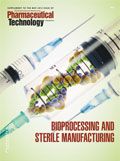Advancing Drug Delivery for Parenteral Applications
Researchers recently developed a drug-delivery system to mitigate problems associated with jet-injection drug delivery, and also improved on the design and operation of microscale actuators as a possible drug-delivery method.
Drug delivery is a multidisciplinary field. Researchers recently developed a drug-delivery system to mitigate some problems associated with jet-injection drug delivery, and also improved on the design and operation of microscale actuators as a possible drug-delivery method.
Researchers at the Massachusetts Institute of Technology (MIT) recently developed a jet-injection drug-delivery system based on a custom high-stroke Lorentz-force motor to mitigate some of the problems typically associated with controlling drug delivery through jet injection. The researchers noted that needle-free drug delivery by jet injection typically is achieved by ejecting a liquid drug through a narrow orifice at high pressure, thereby creating a fine high-speed fluid jet that can readily penetrate skin and tissue. The researchers assert that such injection systems use force- and pressure-generating principles that cause injection in an uncontrolled manner with limited ability to regulate delivery volume and injection depth. To address these shortcomings, the researchers developed a controllable jet injection device, based on a custom high-stroke linear Lorentz-force motor that is feed-back controlled during the time-course of an injection (1).
The key part of the design is the Lorentz-force actuator, a magnet surrounded by a coil of wire that is attached to a piston inside a drug ampul, according to a May 24, 2012 MIT press release. When a current is applied, it interacts with the magnetic field to produce a force that pushes the piston forward, ejecting the drug at very high pressure and velocity out through the ampul’s nozzle. The speed of the coil and the velocity can be controlled by the amount of current applied. The resulting waveforms generally consist of two distinct phases: an initial high-pressure phase in which the device ejects drug at a high-enough velocity to breach the skin and reach the desired depth, then a lower-pressure phase where drug is delivered in a slower stream that can easily be absorbed by the surrounding tissue, according to the MIT press release. Through testing, the group found that various skin types may require different waveforms to deliver adequate volumes of drugs to the desired depth (1).
The team is also developing a version of the device for transdermal delivery of drugs ordinarily found in powdered form by programming the device to vibrate, turning powder into a fluidized form that can be delivered through the skin much like a liquid, according to MIT release. Such a powder-delivery vehicle may help mitigate the problems associated with needing a cold-chain system for delivering vaccines and other biopharmaceuticals.
In another development, researchers at the US Department of Energy (DOE)’s Lawrence Berkeley National Laboratory (Berkeley Lab) and the University of California, Berkeley, have developed an new microscale actuator based on an vanadium dioxide that expands and contracts in response to a small temperature variation and which show promise for drug delivery among other applications.
Piezoelectric actuators are the industry-standard for mechanical actuation on micro scales, but they are complicated to grow, need large voltages for small displacements, and typically involve toxic materials such as lead, according to a Dec. 2012 Berkeley Lab press release. The researchers’ device is simpler, uses nontoxic materials, and creates a displacement that is larger at a lower driving voltage. It works equally well in water, making it suitable for biological and microfluidic applications. The researchers envision using the microactuators as tiny pumps for drug delivery (2) .
References
1. A. Taberner, N.C. Hogan, and I.W. Hunter, Medical Eng. & Physics, online, DOI/10.1016/j.medengphy.2011.12.010, Jan. 13, 2012.
2. J. Wu, Nano Lett., 12 (12), 6302-6308 (2012).

Pharmaceutical Tariffs Are Imminent: How Industry is Bracing for Impact
April 16th 2025On April 14, 2025, the Trump Administration launched a national security-driven investigation into pharmaceuticals, a move that will likely result in tariffs being placed on pharmaceutical drugs, ingredients, and other components that are imported from outside of the United States.
Drug Solutions Podcast: A Closer Look at mRNA in Oncology and Vaccines
April 30th 2024In this episode fo the Drug Solutions Podcast, etherna’s vice-president of Technology and Innovation, Stefaan De Koker, discusses the merits and challenges of using mRNA as the foundation for therapeutics in oncology as well as for vaccines.